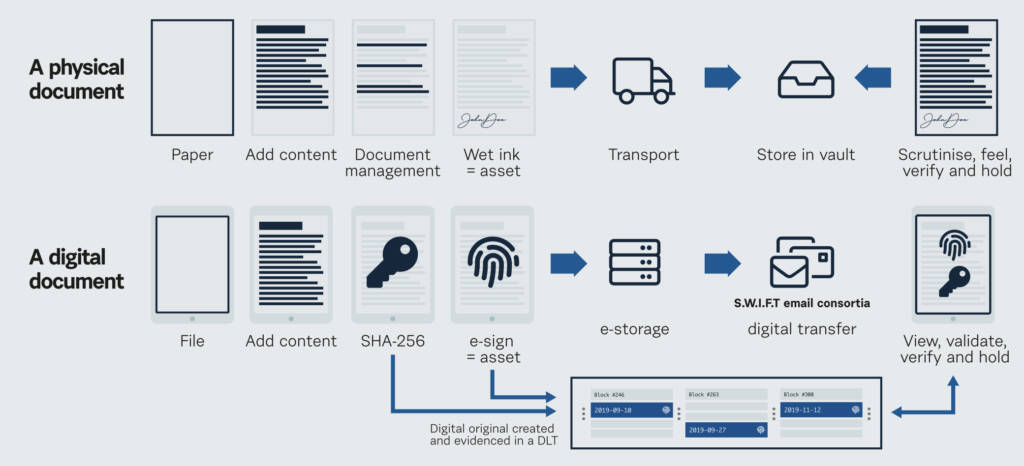Legislators across the globe have long debated how to create and implement a sustainable framework to facilitate the use of digital original documents as negotiable instruments in international trade. The UNCITRAL Model Law on Electronic Transferable Records (MLETR) provides a workable framework for such legislation, but there’s still a long road ahead.
Enigio is at the forefront of digital document technology. It is now clear that with the trace:original, a technical and practical solution exists to create true digital original documents.
If a technical solution meets the requirements laid out in MLETR, commonly called Model Law, it can call itself a legitimate instrument. The Model Law sets out the criteria to determine what exactly constitutes a functional equivalent to a physical document. In short, where Enigio provides a practical solution, the Model Law provides a framework which has the potential to achieve international acceptance.
The MLETR framework aims to reduce friction in international trade by promoting digitalisation, and at the same time making clear the rights, responsibilities and obligations of all parties associated with the negotiable instrument. This goal is emphatically shared by Enigio.

Key MLETR requirements
The guiding principle for the MLETR is a functional equivalence. Let’s first start by highlighting some key provisions regarding which instruments achieve functional equivalence reliably:
Model Law equates ‘accessible information data’ to ‘writing’ and a ‘reliable means of electronically identifying a person’s identity and intentions’ to ‘wet-ink’ signatures. Although many jurisdictions around the world already accept electronic data in place of information and signatures on paper documents, this would effectively guarantee it with respect to negotiable payment instruments and documents of title. It also leaves the precise method up to the designer, making signatures and information accessibility technology agnostic.
It sets out the requirements for transferable documents or instruments to be recognised as an Electronic Transferable Record (ETR). Three key elements must be present on a reliable basis: (1) a method of identifying the record as the ETR, (2) a method of rendering the record under exclusive control until it ceases to have an effect, and (3) retention of integrity of the information (and signatures) within. In other words, any technical solution must reliably achieve exclusive control over a singular document and maintain its integrity throughout the instrument’s full life cycle.
The Model Law also provides specifics relating to the requirement of possession by way of exclusive control of an ETR. If a reliable method is used to establish control and to identify who has control, the ETR is as much in ‘possession’ as the physical document would have been. This, in tandem with the singularity requirement, makes the ETR a digital ‘original’, although the use of the term ‘original’ is deliberately bypassed.
Finally, in Article 12, the Model Law provides a reliable standard by which any solution would be judged. The list of aspects provided is non-exhaustive and provides guidelines both for courts/arbiters and for designers of any solution aiming to comply.
While the remaining provisions are also important, these sufficiently illustrate the regulatory framework provided, focusing on functional equivalence while leaving substantive national legislation for the relevant instruments intact.

trace:original as a Model Law compliant solution
Returning to trace:original, the technology is perfectly aligned with the guiding requirements laid out in the Model Law:
It is signature and information agnostic, allowing the user to create instruments in accordance with national legislation and use acceptable electronic signatures. It is also uniquely identified by cryptographic hashes, published on a blockchain, which also guarantees that the document remains unaltered. This also means the integrity is maintained, without the need of publishing personal data or business information on a blockchain.
The person in sole control of a trace:original document is the holder of the corresponding private key, with the public key published on a blockchain to allow ownership to be securely verified. Not only is ownership exclusive, it provides confidence to any transferee. This exclusive control is also freely transferable, with no requirements besides access to a computer and connection to the internet. Full document portability is a key feature of negotiable instruments and documents of title in international trade.
In essence, the required aspects of an ETR are achieved while maintaining a reliable standard for each component, leaving trace:original as the perfect document technology for the creation and maintenance of digital negotiable payment instruments and documents of title.

trace:original and other important aspects
There are many other important aspects to consider when dealing with electronic transferable original documents:
- Verifiability: Third parties may need to be confident of the integrity of the document or of the identity of its holder, trace:original meets all of these needs. Furthermore, the ability to verify that any copy of the original that is presented as evidence throughout the course of a transaction is identical to the current legally valid digital original, as well as being able to produce such a copy, is also easily done with trace:original. If the verification is done while also being the owner of and presenting a private key, with evidence of corresponding public key published as the owner key on the blockchain, the returning result would be that the ETR is the original and the owner is then able to manage the record according to allowed operations.
- Data privacy: Certain contracts such as those between banks and their customers, will often contain duties of confidentiality. In some jurisdictions these duties are implied by law even if the contract itself is silent. In addition, the holding and processing of personal data in electronic form is subject to regulation in many jurisdictions, like the GDPR in the European Union. This protection may include a “right to be forgotten”, i.e., a right to have one’s data purged from an electronic system where it is stored. Thus, there may be data included in the digital document which an entity may not be permitted to disclose publicly. These obligations are fully catered for with trace:original, as any business or personal information is only stored in the digital original document and nowhere else.
- Procedural formalities: These are important for any negotiable instrument or document of title, as the documents may come to be challenged by the stated obligor or performer. A trace:original document can be presented in accordance with procedural formalities at any enforcement agency or court. For the rare cases where digital evidence is not accepted, trace:original can also fulfil those requirements by transferring the trace:original on to a tangible object (e.g. USB devices) containing the enforceable record. In doing so the original digital document is housed in a technological device which is compatible with all computer systems and can be delivered physically.
The Model Law was very forward-thinking when it was introduced, leaving the designers of technology that supports functionally equivalent records the freedom to achieve legitimacy in different ways. The key guiding principles of functional equivalence are visible in the framework, as well as in the construction of trace:original, which is able to function within existing infrastructures and without disrupting substantive law – the perfect fit for which the time has come.



























